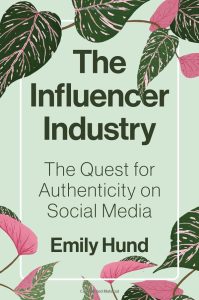In The Influencer Industry: The Quest for Authenticity on Social Media, Emily Hund examines how digital creators seeking work after the 2008 financial crash spawned a multi-billion-dollar industry that has redefined culture, social media and advertising. Tracing the mass-marketisation of social influence, Hund unpicks the elusive concept of authenticity and offers an essential analysis of the “economics of influence,” write Mark Carrigan and Milan Stürmer.
The Influencer Industry: The Quest for Authenticity on Social Media. Emily Hund. Princeton University Press. 2023.
 Influencers are everywhere. At least it can often feel this way.
Influencers are everywhere. At least it can often feel this way.
After peaking in the eighties and nineties, the pejorative term “sellout” has gone out of fashion. Now things are just “cringe.” Both terms seem to refer to some type of failure in the performance of authenticity, but cringe is a description of a personal trait rather than an economic relation and it seems harder to pin down exactly what prompts its use. It’s not that there were once clear-cut markers for being a sellout – think Bob Dylan being charged with “wearing a sellout jacket” (black leather) in an interview with Nora Ephron – but sellout communicated a defined, albeit perhaps naive, analysis. Art and personality were supposed to remain uncompromised by commercial culture and industry, and a failure of this was a failure in one’s authenticity. The twentieth century was full of artists and media personalities twisting and turning to navigate the demands of a cultural industry and their own claim to authenticity.
Art and personality were supposed to remain uncompromised by commercial culture and industry, and a failure of this was a failure in one’s authenticity.
While some of the old “sellout” mentality is clearly still present in today’s perceptions of authenticity, for many bloggers and social media users, their “sense of ‘realness’ […] had come to exist, in part, because they were not monetized” (56), cringe does not as clearly refer us to an industrial context. Cringe, at first glance, is a judgement based on an individual perception, not because there is no industrial context to this perception, but perhaps because the industry of culture has so deeply infiltrated our lives through social media that it has become hard to see its contours. Emily Hund’s remarkable book is a timely contribution that shows “how, in our current moment, authenticity is not just a social construction but an industrial one, continually tussled over by a sophisticated and complicated profit-making enterprise whose decisions about what expressions of reality are valuable help determine what types of content and tools for communication and self-expression are available to the world’s billions of social media users” (7).
The influencer industry offered opportunities for creative professionals to leverage their social and cultural capital into alternative streams of income.
Hund’s book arrives at a point when the influencer industry has penetrated the mainstream to an unprecedented degree. It is a fascinating moment to reflect on a role which finds itself at the interface between a number of societal transformations: Emerging as a symptom of, and a response to, the economic precarity after the 2008 financial crash, the influencer industry offered opportunities for creative professionals to leverage their social and cultural capital into alternative streams of income. The market for influencers then soared during the COVID-19 pandemic when the public became dependent on social media for retail and social activity. Hund traces this redefinition over the past decade of “social influence as a digital commodity, theoretically available to anyone to cultivate and sell, [where] the industry’s various participants created and enacted a system of arbitrary value that privileged social media visibility, minimized creative risk-taking, and required that participants entwine their online self-representations with commercialism—all while using the performance of authenticity as a measuring stick” (171).
In Hund’s view, the concept of “authenticity” emerged to distinguish between influencers with comparable metrics.
In Hund’s view, the concept of “authenticity” emerged to distinguish between influencers with comparable metrics; it is the je ne sais quoi invoked to explain why one figure can have a greater capacity to generate intended reactions online than another, despite otherwise similar followings on a given platform. It reflects a growing sense that platform metrics cannot be relied upon to measure influence, not least the growth of markets in which followers and reactions can be purchased online. Her analysis of the economics of influence, a sophisticated theoretical contribution grounded in robust empirical research, constitutes one of the most important insights of the book. There is nonetheless at points a lack of clarity concerning how the concept of authenticity is being used; is it a term of art within the influencer marketing, an evolutionary strategy which has been developed through trial and error, or perhaps a combination of the two? This matters because these two interpretations are likely to operate on different timescales, in the sense that how professionals working within this still recent field perceive and talk about their work won’t always match the underlying changes in the platform economy on which this work ultimately depends.
We are currently seeing a significant shift in the business model of social media firms, such as a move towards subscription models and a decline in advertising revenue.
We are currently seeing a significant shift in the business model of social media firms, such as a move towards subscription models and a decline in advertising revenue driven by the economic downturn, with implications for the concept of authenticity which is central to Hund’s analysis Authenticity has a long history as a proxy for creditworthiness, providing the epistemic foundation upon which relations of trust can form. What if we are seeing a breakdown of trust that platform metrics mean an online figure has a status which is salient beyond social media; a capacity to influence beyond the boundaries of these networks? What if we are seeing a breakdown of trust in the significance of platforms more broadly as the platform landscape fragments and the business model shifts to incentivise subscription and paid advertising? This does not mean the figure of the ‘influencer’ will disappear, nor that the economic conditions which render remunerated work possible have fatally atrophied (though the growth of the TikTok intern is a worrying sign for the influencer suggesting that people can perform this role without payment). But it does suggest that a significant shift is underway and that the categories that Hund develops, such as authenticity, might prove less analytically salient for a new phase in which the ‘free trial period of web 2.0’ is over. This is not a critique of the book as much as an attempt to further historicise it, building on the fine-grained way in which Hund locates the origins of the influencer in the carnage generated by the 2007/08 financial crisis in the cultural industries.
Note: This review gives the views of the author, and not the position of the LSE Review of Books blog, or of the London School of Economics and Political Science. The LSE RB blog may receive a small commission if you choose to make a purchase through the above Amazon affiliate link. This is entirely independent of the coverage of the book on LSE Review of Books.
Main Image: alinabuphoto on Shutterstock.







